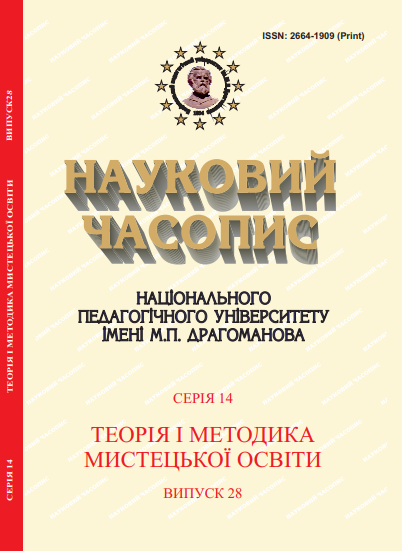Axiologising of choreography-pedagogical education as a modern requirement
DOI:
https://doi.org/10.31392/NPU-nc.series14.2022.28.09Keywords:
axiology, axiological competence, choreographic and pedagogical education, teacher of choreographic disciplinesAbstract
The article examines the conceptual principles of axiologising choreography-pedagogical education in modern conditions. In professional training, axiological competence represents a system of general cultural, artistic and professional values and determines the attitude to the surrounding world, to art and one's activity, to oneself as a person and a professional. It is shown that value-integration orientations characterize the ability of a future specialist to emotionally react to artistic works studied in choreography classes. The importance of such skills in students leads to a deeper perception of works of art and their direct impact on artistic-aesthetic and artistic-pedagogical development.
It is noted that in choreographic art, knowledge always acquires an axiological character, because it is associated with ideas about the significance of choreographic art for the formation of the national self-awareness of schoolchildren, their harmonious spiritual and physical development. This approach to this problem requires the use of axiological orientation in the educational process, the introduction into the system of professional pedagogical training of basic aesthetic concepts and moral categories that characterize the system of universal and national values.
It is proved that the axiologisation of the choreographic-pedagogical competence of the teacher of choreographic disciplines consists of a complex of cognitive, orientation and operational components. Each of them is based on positive value orientations, which ensure an adequate and comprehensive understanding of works of choreographic art and their translation into the educational process. In the activity of a teacher of choreographic disciplines, axiological competence acquires a leading importance, since the very understanding of choreographic art begins, first of all, with the interpretation of his works, with the ability of an individual to perceive them emotionally and intellectually through the prism of an aesthetic ideal.
References
Калюжна Т.Г. Педагогічна аксіологія в умовах модернізації професійно-педагогічної освіти: монографія – К.: Вид-во НПУ імені М.П.Драгоманова, 2012. – 128 с.
Гончаренко С.У. (2011), Український педагогічний енциклопедичний словник. Вид. 2-ге. – Рівне: Волинські обереги. 552 с.
Ткачова Н.О. Історія розвитку цінностей в освіті: монографія. Х. : Видавн. центр ХНУ ім. В.Н. Каразіна, 2004, 432 с.
Падалка Г.М. (2008), Педагогіка мистецтва (теорія і методика викладання мистецьких дисциплін). Київ: Освіта України. 274 с.
Благова Т. Розвиток народно-сценічного танцю у діяльності професійних вокально-хорових колективів ХХ століття. Вісник Львівського університету, 2014, вип. 14, с. 125-130.
Андрущенко В. Світанок Європи. Проблема формування нового вчителя для об’єднаної Європи ХХI століття / В. Андрущенко. – К. : Леся, 2012. – 728 с. – (Філософія освіти: пошук пріоритетів).
Козир А.В. (2008), Професійна майстерність учителів музики: теорія і практика формування в системі багаторівневої освіти: монографія. К.: НПУ імені М.П. Драгоманова. 378 с.
Downloads
Published
Issue
Section
License
Copyright (c) 2022 Nauk. čas. Nac. pedagogìčnogo unìv. ìm. M.P. Dragomanova, Ser. 14, Teor. metod. mistec. osv. [Scientific journal NPDU. Series 14. Theory and methodology of arts education]

This work is licensed under a Creative Commons Attribution-NonCommercial-NoDerivatives 4.0 International License.

